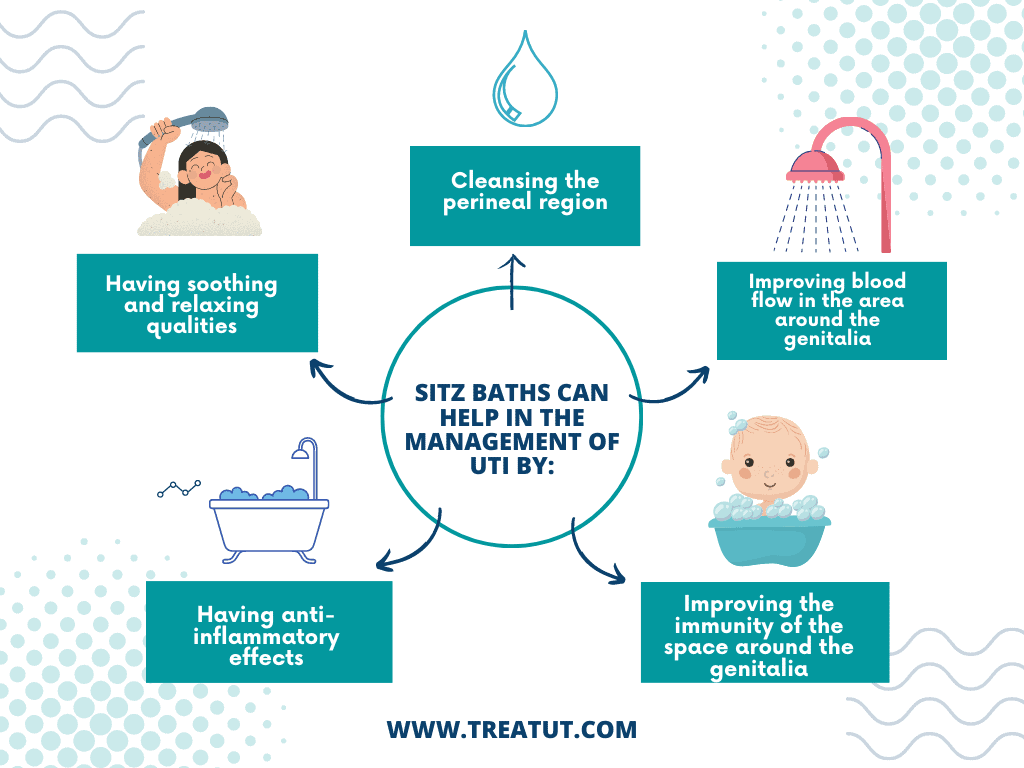Sitz baths can be a good way to soothe UTI pain and decrease inflammation around the genital area, which might cause or be caused by a UTI. Therefore, these baths can play a helping role in the treatment or prevention of UTI.
Warm water sitz baths can improve the blood circulation or blood flow in the perineal region (the space between the anus and the opening of the vagina or penis) and offer some cleansing and relaxing effects.
These kinds of baths can also provide some additional benefits for UTI sufferers depending on what ingredients you add to them and how you use them, but they can also be counterproductive and harmful if used in the wrong ways.
Sitz baths are definitely not a main part of UTI treatment in any kind of way, but they can be considered as supplemental or adjunctive therapy to help in the recovery or prevention process from UTI.

In this article, we are only going to discuss the kind of sitz bath that can be considered as the standard or regular type of sitz bath and its effects on UTI, which is the warm water sitz bath.
To a lesser degree, we are also going to discuss cold or normal temperature water sitz baths and their effects on UTI.
However, if you want to know about other less common kinds of sitz baths, like vinegar, Epsom salt and baking soda sitz baths, and the impact they have on people who have UTI, head over to our what to put in a sitz bath for UTI article.
What is a sitz bath and is it good for UTI?
Sitz baths will not cure you out of anything. They are only a tool that doctors and patients can use to help in the management of UTI.
A sitz bath is the idea of putting water (usually warm water) in constant contact with the perineal region which is the area between the anus and the opening of the vagina or the penis.
A regular sitz bath occurs when people immerse themselves in warm water up to their hips for about 10 to 15 minutes.
They can do that using a bathtub or a sitz bath plastic basin specifically designed for that purpose.
It can also be considered a sitz bath when people bend over under the shower and let the water flow from the lower back to the perennial region for approximately the same amount of time.
You can also point the shower head on the area between the anus and the opening of the vagina and that would also be considered a sitz bath. I find that especially relaxing.
So, the idea is to put warm water in constant contact with the perineal region for a few minutes in order for it to exert its beneficial effects on that area.
These beneficial effects include:
_ Relaxation of the anal sphincter muscles and the urethral sphincter muscles
_ Improving the blood circulation in the area around the genitalia
_ Cleansing that area of some germs
_ Providing some soothing and anti-inflammatory relief from various kinds of pains which can be caused by UTI or which can cause or exacerbate UTI.
Because of these aforementioned qualities that sitz baths are known for, UTI patients and people who want to prevent UTI will definitely benefit from using them.
During a UTI, the perennial region can be infected with lots of kinds of bacteria, especially the E. coli bacteria, and using warm water sitz baths, can help in cleansing that area from those kinds of germs.
Hot or warm water can kill or at least impede the growth of harmful bacteria around the perineal region, and that can help prevent or speed up the recovery process from UTI.
This study shows the positive effect that sitz baths had on the wound-healing process of a kind of wound that patients had in the area between the anus and the vagina, which means that sitz baths do have the ability to treat conditions of bacterial and inflammatory origin.
Urinary tract infection, although it may not look like a wound, is a condition that is caused by bacteria and that is exacerbated and maybe also caused by inflammation.
But, you should be careful not to make the water hotter than your skin can tolerate as that can end up irritating your skin, which is extremely not good especially if you have an ongoing UTI.
Additionally, when sitz baths reduce inflammation and improve the blood circulation around the perineal region, the immunity of the skin around that vulnerable area would be strengthened because of that.
This would make the perineal region of UTI patients more equipped for getting rid of any UTI-causing bacteria or to at least prevent the further passage of harmful bacteria from the anus to the urethra or the bladder through that area.
Inflammation is the enemy of immunity, and anything that can reduce inflammation can improve immunity.
So, in the case of a UTI, a sitz bath can strengthen the immunity of the skin around the genital area, and that will help in the treatment and prevention process of UTI.
Warm water sitz baths can dilate the blood vessels around the perennial region and when these blood vessels get dilated more blood will flow into them, therefore these baths can enhance the blood flow or the blood circulation of the area around the genitals.
The improved perineal blood flow effect of warm water sitz baths is definitely one of the reasons why these baths can exert anti-inflammatory and Immunomodulatory (immunity-enhancing) effects on the area around the genitalia.
The more blood reaches the cells, the more nutrition they will have and the more likely they will be able to fight harmful pathogens and reduce inflammation.
Just as sitz baths can produce relaxation of the anal sphincter muscles, they can also produce relaxation of the urethral sphincter muscles, and that can lead to improved bladder emptying in UTI patients.
This is a major benefit for UTI patients because it will prevent residual urine from lingering in the bladder for any extra amount of time, and that can help prevent the exacerbation of UTI.
Any residual amount of urine in the bladder could be a source of attraction for bacteria and a source of food for them, and that can prevent the fast healing of UTI or worse it may even worsen UTI.
This incomplete bladder emptying that most UTI and cystitis patients experience is responsible for a lot of UTI symptoms including urgency with urination, micturition, incontinence and a burning sensation with urination. A sitz bath can help prevent that. See this study.
Many patients have reported that sitz baths have a great soothing and relaxing effect, so definitely that will help in easing some of the UTI pain and discomfort symptoms.
When a UTI is mild, it’s not necessary to call for a doctor, so you can try out using a sitz Bath in order to help prevent the UTI from developing into a more serious condition.
But, if the UTI persists or worsens then it’s definitely necessary to call the doctor right away.
Also, when the symptoms are very strong it would be better to call the doctor right away and then you can ask them if you can use a sitz bath as an addition to the antibiotics and other kinds of treatments they would prescribe for you.
To summarize
Sitz baths can soothe, relax and improve blood circulation in the perineal region, which can result in improved bladder emptying and reduced inflammation in people with UTI.
All of this can be extremely beneficial for UTI treatment and prevention, but in serious cases, you need to see a doctor.

General notes and precautions with sitz baths
With warm water (regular) sitz baths you can raise the temperature of the water to the degree that your skin around the perineal region can tolerate.
But, be careful not to scald yourself as that can end up irritating or aggravating the skin around the genitalia and causing more harm than benefit to your UTI condition.
Make sure that the tub or basin you are using is clean before taking the bath to prevent the possibility of contamination.
Also, make sure that the water you are using is clean too.
After taking any kind of sitz bath make sure to wash your perineum or the area around your genitals thoroughly with water and then pat yourself dry with a soft piece of cloth.
This measure is to make that the area is not moist or humid after you take the bath as moisture in that area can lead to fungal infections.
If you do not find yourself becoming better after a short period of time or if your condition is getting worse, call your doctor or pharmacist immediately.
Warm water or regular sitz baths duration is about 10-15 minutes.
You can take them 2 or 3 times a day regardless of whether you want something to help you with an ongoing UTI or you want to prevent UTI.
People who suffer from recurrent UTIs or people who find that UTIs are always coming back to them can find warm water sitz baths especially beneficial and useful for them.
One of the best uses of sitz baths for UTI people
Some doctors recommend using sitz baths after bowel emptyings in order to reduce the possibility of infection in any part of the urogenital tract.
This is especially true for people who have bowel issues, like irritable bowel disease, chronic constipation or diarrhea and so on.
After each bowel movement or bowel emptying, bacteria, like the E. coli bacteria, will have the chance to come out of the anus and some of them can cling to the skin around the perennial region.
In some cases, these bacteria might get the chance to invade the urinary tract and cause a urinary tract infection.
Bowel problems, like irritable bowel disease, might not be of bacterial or fungal origin.
However, with people who suffer from them, after each bowel emptying the chance of more pathological or harmful germs or bacteria coming out of the digestive tract and sticking to the perennial region would be much more increased.
That’s why these kinds of conditions are heavily linked and associated with urinary tract infections. See this research.
One of the good ways to mitigate this problem, especially for those people who suffer from bowel issues, is through using warm water sitz baths after bowel movements.
Warm water (regular) sitz baths can reduce the possibility of urinary tract infection that might occur because of Bacterial immigration or transportation from the anus to the urinary tract.
These baths might decrease bacterial load around the perineal region after bowel emptyings, thereby helping reduce the possibility of UTI, especially for people who suffer from bowel issues.

Cold water or regular temperature water sitz baths vs warm water sitz baths for UTI?
Cold water sitz baths are good for other kinds of conditions like hemorrhoids or perineal edema, but they’re definitely not good for the purpose of UTI prevention or treatment.
The reason for that is that they can’t increase or improve perineal blood flow just like warm water sitz baths do.
Therefore, they won’t be able to decrease inflammation or improve the immunity of the area around the anus and urethra and in between.
These baths might even raise the risk of bacterial dissemination or spreading around the genital area, although the possibility of that is very low, especially if the water and the tub that was used were clean.
Can sitz baths treat yeast infections?
Yeast infections are usually heavily associated with UTI and the women who have them would typically also have a UTI and vice versa.
fungal infections, contrary to bacterial infections, are usually more resistant to treatment, and usually, they do not resolve on their own such as bacterial infections do in many cases.
For example, most UTIs resolve on their own without any kind of medical intervention or with the simple use of some home remedies like sitz baths, drinking orange juice and so on.
See our home remedies article for more information on that subject.
But, fungal or yeast infections usually need Strong antifungal medication, especially if they were associated with a UTI or bacterial infection in the urinary tract at the same time.
Then the possibility of treating them with home measures is close to none.
So, you can only use sitz baths for preventative purposes with these kinds of infections, especially if they were associated with a UTI.
Also, you can use sitz baths as an adjunctive part of therapy in addition to the therapy that your doctor has prescribed for you.
Do not delay going to the doctor or asking your pharmacist as you are waiting for the sitz bath to take effect because it’s not going to work on its own at all in this case.
Go to the doctor and receive proper treatment and then use the sitz bath as an addition to the doctor’s treatment.
After being healed from the yeast infection, you might also use sitz baths for preventative purposes to help prevent yeast infections and UTIs from coming back to you.
Article summary
- Warm water sitz baths can increase the blood flow into the perineal region, hence improving immunity and reducing inflammation.
- A warm water sitz bath can help reduce inflammation and improve the immunity of the perineal region (the area around the genitals).
- Because of its soothing and anti-inflammatory properties, warm water sitz baths can ease some UTI pain and discomfort symptoms.
- Warm water or regular sitz baths induce relaxation of the anal and the urethral sphincter, which means that these baths can make UTI patients pass higher quantities of urine with each time they go to the bathroom.
- Sitz baths can prevent UTI patients from leaving residual amounts of urine in the bladder after urination, and that can prevent UTI exacerbation.
- People with bowel problems are susceptible to UTIs, and using warm water sitz baths after bowel emptyings might reduce that risk.
- In the more serious UTI cases, a sitz bath can be used as an adjunctive therapy aiding in the treatment process but definitely not the main part of the treatment plan because patients will need antibiotics at this point.
- A warm sitz bath will promote perineal hygiene better than a cold or regular-temperature water sitz bath.
